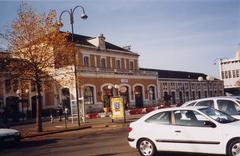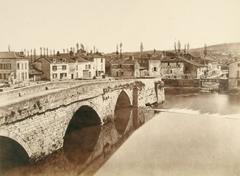Porte Normande Visiting Hours, Tickets, and Guide to Périgueux Historical Sites
Date: 14/06/2025
Introduction
Nestled in the historic heart of Périgueux, France, the Porte Normande stands as a testament to the city’s rich heritage, which spans from its Gallo-Roman origins to the medieval era. Originally constructed as part of the 3rd-century ramparts of Vesunna—the Roman predecessor of modern Périgueux—this ancient gate embodies centuries of architectural evolution and cultural significance. Built using local limestone and spolia (reused Roman materials), the Porte Normande served as a vital northern gateway, both facilitating access and defending the city against threats such as Viking incursions in the 9th century (Seevisit, Le Nez dans l’Herbe).
Today, the Porte Normande is an open-air monument seamlessly integrated into Périgueux’s urban fabric. Its architecture reflects a blend of late Roman military engineering and medieval adaptations, with visible reused stones and decorative remnants that narrate the city’s layered past (pop.culture.gouv.fr, francerent.com). Beyond its physical presence, the gate symbolizes the resilience and continuity of Périgueux through turbulent periods, including the Hundred Years’ War and the Wars of Religion.
Accessible year-round without entrance fees, the Porte Normande offers a flexible and enriching experience. Guided tours, provided by the local tourist office, offer deeper insights into the monument’s history and its relationship to nearby landmarks such as Château Barrière, the Vesunna Gallo-Roman Museum, and the UNESCO-listed Saint-Front Cathedral (Guide du Périgord, ArchDaily).
This guide provides detailed information on the Porte Normande’s historical context, architectural significance, practical visiting details, and nearby attractions to help you plan an unforgettable visit to one of Périgueux’s most emblematic monuments.
Contents
- Origins and Construction of the Porte Normande
- Architectural Significance
- Historical Role and Transformations
- Visiting Information: Hours, Tickets, and Accessibility
- Guided Tours and Visitor Tips
- Nearby Attractions and Itineraries
- Local Life, Gastronomy, and Events
- FAQ
- Visuals and Media Recommendations
- Summary and Visitor Recommendations
- Sources and Further Reading
Origins and Construction of the Porte Normande
The Porte Normande is a significant relic of Périgueux’s ancient fortifications, with origins tracing back to the 3rd century CE. During this era of instability in the Roman Empire, Vesunna—modern-day Périgueux—constructed a robust circuit of ramparts, punctuated by monumental gates like the Porte Normande, to protect against invasions (Seevisit).
Constructed with local limestone and recycled materials from earlier Roman buildings, the Porte Normande was strategically positioned as the city’s northern exit. Its architecture reflects defensive priorities, serving both as a thoroughfare and bulwark against external threats.
Architectural Significance
The Porte Normande exemplifies late Roman military engineering, adapted to an urban context. While much of the original superstructure has been lost, surviving elements reveal a gateway flanked by thick masonry walls, likely topped with defensive parapets. The use of spolia—reused decorative stones from earlier Roman monuments—illustrates both practical reuse and a symbolic link to the city’s illustrious past (Le Nez dans l’Herbe).
Proximity to other remnants, such as Château Barrière and Maison Feroilh, highlights the Porte Normande’s integration into the evolving city. Over centuries, these Roman walls served as foundations for later medieval and early modern buildings, demonstrating the enduring adaptability of Roman construction.
Historical Role and Transformations
Originally a defensive entry point, the Porte Normande’s name is traditionally linked to Viking (Norman) incursions in the 9th century. Local tradition holds that the gate played a defensive role during these invasions, symbolizing the city’s resilience (Seevisit).
Throughout the Middle Ages and into the Renaissance, the fortifications, including the Porte Normande, were periodically repaired and adapted to shifting political and military circumstances. As threats diminished, the city expanded beyond the ancient walls, and the gate’s military function gave way to its role as a historical landmark. Archaeological interest and preservation efforts in the 19th and 20th centuries have ensured its survival and integration into the city’s modern landscape (Le Nez dans l’Herbe).
Visiting Information: Hours, Tickets, and Accessibility
Visiting Hours and Tickets
- Access: The Porte Normande is an open-air monument, accessible year-round, 24/7. There are no entrance fees or tickets required (Guide du Périgord).
- Best Times to Visit: For optimal lighting and fewer crowds, visit during daylight hours—early morning or late afternoon from May to September are ideal.
Accessibility
- General Accessibility: The site is easily accessible on foot from Périgueux’s city center and main squares. The area features cobblestones and some uneven terrain, so visitors with mobility challenges should exercise caution.
- Facilities: Cafés, restaurants, public restrooms, and the Tourist Office are all within a short walk of the site.
Guided Tours and Visitor Tips
- Guided Tours: The Périgueux Tourist Office offers guided tours including Porte Normande and other key historical sites. Tours run from June to September, with group tours available year-round by reservation. For updated schedules, contact the Tourist Office at +33 (0)5 53 53 10 63 (Guide du Périgord).
- Self-Guided Routes: Maps and walking routes are available at the Tourist Office, with interpretive signage (in French and sometimes English) at major sites.
- Photography: The ancient stonework is particularly photogenic in soft morning or evening light.
Nearby Attractions and Suggested Itineraries
Combine your visit to the Porte Normande with these nearby highlights:
- Vesunna Gallo-Roman Museum: Explore Roman-era artifacts and immersive exhibits in a modern glass-walled setting (ArchDaily).
- Tour de Vésone: The iconic Roman temple tower and surrounding archaeological park.
- Saint-Front Cathedral: A UNESCO World Heritage site renowned for its Byzantine domes and panoramic rooftop views (France Voyage).
- Château Barrière: A medieval fortress marking the city’s transition from Roman to medieval periods.
- Jardin des Arènes: A public park incorporating the remains of a Roman amphitheater (Guide du Périgord).
The Tourist Office provides themed itineraries focusing on Gallo-Roman, medieval, and Renaissance Périgueux.
Local Life, Gastronomy, and Events
- Markets & Gastronomy: The area around Porte Normande hosts lively markets on Wednesdays and Saturdays, featuring Dordogne specialties like foie gras, truffles, walnuts, and cheeses (Over Your Place).
- Events: Cultural events, including the medieval festival at Château Barrière, open-air concerts, and the MIMOS street arts festival, enliven the district year-round (Destination Périgueux).
- Outdoor Activities: Enjoy the Voie Verte cycling and walking path along the Isle River, or hiking in nearby countryside.
Frequently Asked Questions (FAQ)
Q: Are tickets required to visit Porte Normande?
A: No, the monument is open to the public free of charge at all times.
Q: What are the visiting hours?
A: The gate is accessible 24/7 as an outdoor site, with the best experience during daylight hours.
Q: Is Porte Normande accessible for those with limited mobility?
A: The area is generally accessible, though some cobblestone streets may pose challenges. Contact the Tourist Office for specific accessibility information.
Q: Are guided tours available?
A: Yes, guided tours are offered by the local tourist office from June to September, with year-round group options by reservation.
Q: Where can I find nearby facilities?
A: Cafés, restaurants, shops, public restrooms, and the Tourist Office are within a short walk.
Visuals and Media Recommendations
- Include high-resolution images of Porte Normande’s exterior, the surrounding medieval quarter, and nearby monuments.
- Use alt tags such as “Porte Normande visiting hours” and “Périgueux historical sites” for SEO.
- Embed virtual tours or interactive maps from the Tourist Office website to enhance planning (Guide du Périgord).
Summary and Visitor Recommendations
The Porte Normande remains a captivating gateway into Périgueux’s history, bridging the ancient Roman city of Vesunna with the medieval town that followed. Its enduring stonework, enriched by reused Roman materials and medieval modifications, offers a tangible connection to the city’s evolving identity (Seevisit, pop.culture.gouv.fr). As a free and accessible monument in the heart of Périgueux’s old town, it is the perfect starting point for exploring the area’s rich tapestry of museums, cathedrals, and lively markets.
Preservation efforts have safeguarded the Porte Normande’s legacy, ensuring it continues to symbolize the resilience and adaptability of Périgueux’s community across centuries (Wikimedia Commons, ArchDaily). Whether you’re drawn by its historical significance, architectural detail, or proximity to vibrant local life, the Porte Normande is a must-see for any visitor.
For the latest news, guided tour schedules, and travel tips, download the Audiala app, consult the Périgueux Tourist Office, and follow local channels for event updates. Embark on your journey through Périgueux’s remarkable past and present at the Porte Normande—the enduring gateway to the city’s story.
Sources and Further Reading
- Seevisit – Porte Normande
- Le Nez dans l’Herbe – Périgueux Antique
- Mérimée Database (pop.culture.gouv.fr) – Porte Normande
- FranceRent.com – Porte Normande
- ArchDaily – Gallo-Roman Museum Vesuna
- Guide du Périgord – Visiting Perigueux
- Places and Things To Do – Périgueux Sightseeings
- Destination Périgueux – Events and Information
- Wikimedia Commons – Porte Normande (Périgueux)
- Guide du Périgord – Gallo-Roman Heritage Trail
- Over Your Place – What to See in Perigueux

